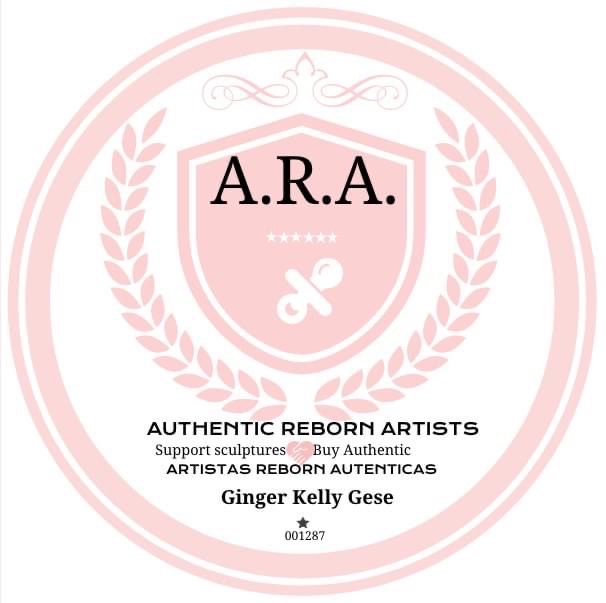Authentic vs Fake

Often times you will hear the word “authentic” reborn but, with that you will almost always hear the other word, “fake”. This article is for those of you who are new to the reborn world and, maybe some of you who are not aware. I want to talk about the difference between authentic vs fake sculpts or better said, COUNTERFEIT! Yep, you heard that right. To understand the difference we need to start at the beginning. What are reborns?
The word “reborn”, is often confused with being a term used to describe a type or brand of doll when in fact it is NOT. “Reborn” is a word artists use to describe the act of creating dolls to look as lifelike as possible, all by hand. So where did this term originate from? The history is very vague and unclear as to who actually started or coined the term “reborn”. However, if you look back, we have had an obsession with dolls dating back to 200 BC, possibly even earlier. Fun fact, one of the oldest dolls ever found was called a wooden paddle doll. First discovered in ancient Egyptian tombs in 2000 BC.
Throughout history, dolls have been used for many reasons. They have been used for protection, and seen as gods or messengers from our ancestors. They were used in religious ceremonies or effigies for magic and so much more. As people have evolved so have dolls and their meanings or purposes. When we get into the 20th century, dolls make an even bigger leap into the new age of the industrial era. Being made using the newly invented polymer and plastic materials. It wasn’t until around the 1990”s when the idea of taking an old doll and making it new and or more lifelike, really took off. Some of the greats in developing the concept of “reborning” could be attributed to Lee Middleton. When she couldn’t find dolls that looked like her children, she sculpted her very own. Or Joyce Moreno who decided to use the head of her Berenguer doll to recreate it in the way she envisioned. These are just two people of many masters in the art of doll making.
As the practice of sculpting and the pursuit of creating dolls to look as lifelike as possible grew, so did the term “reborning”. Making something old new or in your likeness, by hand painting and creating. The world grew more and more fascinated and hungry to find these life-like dolls, only available to the few. The process of creating these dolls by hand took a lot of time and money (and still does!). Some people decided to take “shortcuts” to produce the dolls faster and cheaper. They have been riding on the backs of those who paved the way. Targeting the market for those who are seeking lifelike or “reborn” dolls. Instead of hand sculpting their own dolls, they decided to illegally reproduce someone else’s work. STEALING art. These people would make molds over another artist’s sculpt and mass-produce them. Marketing these dolls as “reborns”. The word is not being used as a verb, describing the ACT of creating lifelike dolls by hand. No, they started using the term “reborn” as a noun. Being a type or brand of a doll. When in fact it was the complete opposite. The dolls are being mass-produced in factories by machines, not people. Because of this, all the painstaking details an artist would do would get lost in the reproduction. By the time the dolls are done being re-produced, they are only dolls, not art. No longer are those “authentic” handmade reborn art dolls. Now, only knock-off factory-made “fakes”.
Because of this, the art of making dolls has taken a big hit. Sculptors, having more and more of their work stolen are discouraged from wanting to even sculpt at all. Not being compensated for all the time, work, and money involved in creating these beautiful sculptures in the first place. This makes it incredibly difficult for other artists who rely on our amazing sculptor’s work. This is causing a ripple effect impacting the entire doll community. Don’t be fooled you can not buy “authentic” reborns or sculpts from places like Amazon, Temu, Walmart, Target, websites that say “sponsored” or other big brand stores or websites. These dolls are “fake”! True “authentic” reborns can only be purchased from an artist created by an artist.
If you are looking for a reborn ask for references. Require them to send you a “safety photo”, a photo with the date and name of the person written on a piece of paper held next to the doll. You can ask for them to include a specific object in the photo, to prove the doll is in their possession. Countless Facebook pages are scams. One of the things to look out for is the date the page was created. How many followers or friends do they have and if any are artists known in the reborn community. Does their profile photo actually match the page or person it is representing? Cross-check their friends or followers. Almost always photos are stolen unknowingly from the actual artist. Often times things don’t quite make sense. If it’s too good to be true, it probably is. Do your homework when buying. Don’t rush into anything and if they pressure you they most likely are trying to scam you. Never buy using PayPal, friends or family. Make sure your purchase is backed and insured in case things do not go your way. You can almost always expect to pay on the absolute low end of $300 (if created by a new artist) and up.
Help the entire art community by only buying “authentic” reborn art dolls and steer far and away from “fakes”.

